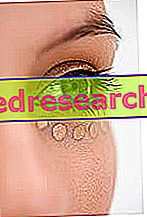Look tired
Often the signs of aging are more evident in the periorbital area, including wrinkles and dark circles that determine a typical and unsightly "tired look".

Remedies
In general, treatments with depigmenting agents (lightening substances) must be carried out for many months before obtaining cosmetic benefits, and often these products are burdened by heavy side effects, which make their use contraindicated, especially in such a delicate area as the eye contour.
How the depigmentants work
The mechanisms of action of these substances can be summarized as:
- Inhibition of tyrosine activity
- Inhibition of DNA synthesis in melanocyte hyperactivity
- Reduction of melanin content in the epidermis
- Thickening of the granular layer of the epidermis
What are they?
Among these substances that interfere with the processes of pigmentation of melanin, we recall:
- HYDROKINONE : it is considered the most effective "whitening agent" and is still used today to treat hyperpigmentation problems. In fact, it inhibits the synthesis of DNA and RNA, and induces the degradation of melanosomes and the destruction of melanocytes. Already in 1975 two scientists, Dr. Kilgman and Dr. Willis, carried out a first study to evaluate the efficacy of hydroquinone: after 5-7 weeks of treatment the first positive results were had, even if it should not be forgotten, however, that the treatment should be extended from three months to one year. The experiment was not carried out using only this cosmetic ingredient (5%), but a 0.1% tretinonin and a 0.1% dexamethasone were also used. The problem is that the mix of these products involved side effects including erythema, desquamation, irritation and contact dermatitis.
- Hydroquinone has multiple side effects, such as skin irritation, dermatitis, cytotoxicity, permanent hypomelanosis or amelanosis. The poor safety of use of the compound has led the European Commission to prohibit the use of hydroquinone in cosmetic products, limiting its use as a skin lightening to medical and dermatological prescriptions.
- RETINOIC ACID : currently, it is believed that a concentration of retinoic acid ranging from 0.01% to 1% reduces pigmentation by inhibiting transcription of the transferase, leading to thickening of the granular layer of the epidermis. The number of melanocytes is apparently unchanged, but the damage to them appears evident. Retinoic acid must be applied with longer treatments than hydroquinone; significant bleaching occurs after 24 weeks, although side effects similar to the previous depigmenting agent have been reported: flaking and pungent burning.
- Retinoids (including retinoic acid, not allowed in cosmetology) are considered compounds with a medium / deep action, so their use is mainly linked to the ambulatory environment; they too can be irritating.
- AZELAIC ACID : it is a dicarboxylic acid used usually in the treatment of melasma (facial hypermelanosis which shows a brown color: it is a typical problem of women, in particular those that often expose themselves to the sun, and is used to reduce the freckles left from acne, to combat hair loss and against papulopustular rosacea.It has anti-inflammatory, comedolytic, antibacterial and low toxicity properties, although its use in cosmetics is prohibited because it is irritating.
- COGIC ACID : kojik acid is a natural substance produced by mushrooms of the genus Aspergillus (whose Japanese name is koji) and is a by-product of the rice fermentation process. It is used in foods and cosmetics to change the color of substances: for this reason it is considered a depigmenting and lightening agent. At skin level, it inhibits the synthesis of melanin and is used in the treatment of melasma or chloasma (a disorder that presents typical dark spots due to a change in hormones: pregnant women often suffer from this problem).
Kojic acid and azelaic acid are allowed but dermatitis, contact allergy and sensitization have been reported after use.
Conclusions
Due to the various factors that cause the dark circles it is essential to identify the triggering cause before starting any treatment: for example, if the shading in the lower eyelid is due only to excessive pigmentation, then the melanin deposited can be removed with topical treatment through whitening agents; if, on the other hand, the dark circles are caused by the swelling induced by a pathology or in any case by an allergy, the imperfection cannot certainly be treated with these substances. However, specific treatments are required for the eye area, taking into account that the area around the eyes has a much thinner and more permeable skin than the rest of the face. It is good to prefer safe molecules capable of modulating the process of melanogenesis in a minimally invasive and reversible way, such as ellagic acid, licorice extract or niacinamide.



